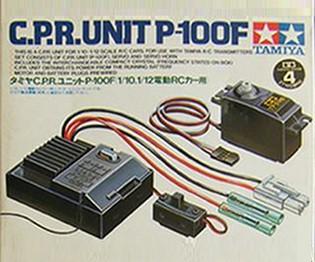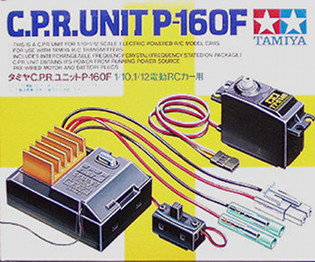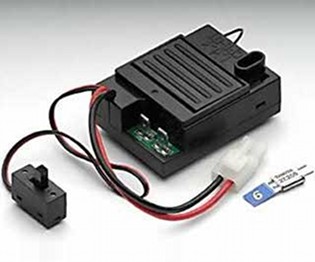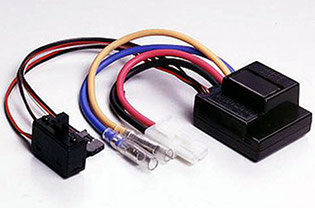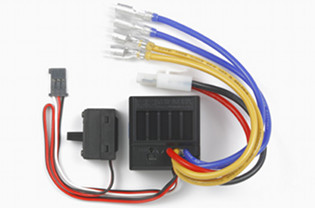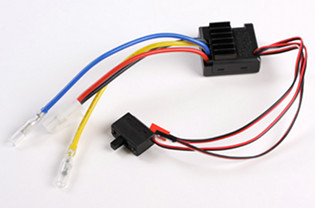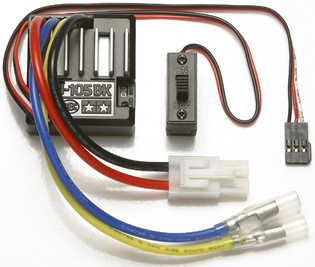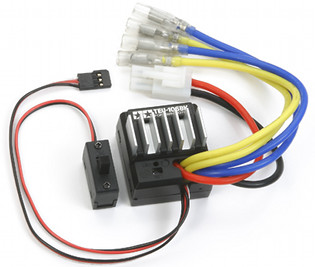блин, пол-года уже почти, ну ладно..
всем привет, у меня проблема сосбственно с данным регулем. при включении он нормально реагирует и даже пищит, но сразу же после этого он начинает ровно мигать * * * *… на передатчик не реагирует вообще. перенастрйка не помогла… Пожалуйста, подскажите, что с ним делать?
З.Ы.: на новый денег нету; поиск на форуме и в интернете не дал ничего, кроме инструкции, которая у меня есть и в которой ничего по этому поводу не написанно. А если написанно, то тыкните меня, пожалуйста, носом в нужное в ней место…
__________________
невменяем, неадекватен, убиваю шаськи, спасаю бодики
зовут Василием, так на всякий случай…
Chassis:
OTA Street Jam.
HPI Sprint 2
TT-01
(на 15% разобрана)
Извините за тупые вопросы по электронике, просто раньше только ДВС-ка была…
- You are here:
-
Home
-
Downloads
-
Categories
-
ROOT
-
Tamiya Parts instructions
-
45041 Tamiya TEU-104BK ESC
| Overview | Search | Up |
Download details
|
Instruction sheet for the Tamiya TEU-104BK ESC |
|
Back
Powered by jDownloads

Page 2 of 4
An Electronic Speed Controller (or ESC) works using transistors (called FET) which role is to slice the constant current from the battery pack into impulses. These impulses are separated by pauses during which no current is supplied: the longer the pauses, the more the motor gets voltage. The impulse frequency is controlled electronically, which offers the progressiveness MSCs were lacking. Another advantage of ESCs is autonomy («battery life»): in fact, the job of the ESCs is to frantically switch the motor «on» and «off» (thousands of times per second), thus switching «on» and «off» the battery. So the battery is used «on demand» and no longer in continuous with partial heat dissipation of the unused current like with MSCs. The result is a much greater autonomy (or battery life, again).
Tamiya first ESCs were combining the radio receiver: none of them was supplied in any kit box though. The first mention of an electronic speed controller can be found in the manual of kit 58067 Thundershot from 1987. The device was a C.P.R. Unit P-100F capable to handle motors down to 17 turns. Soon after, the C.P.R. Unit P-160F handled motors down to 12 turns. A more economic version called C.P.R. Unit P-80F (motors over 23 turns) was also released before the last device called CPR-01 (27 turns) was supplied with XB models. Reference of this last CPR unit can be found in about every manual of the TT-01 chassis and TL-01 chassis based models. We will discuss further on the question of «turns» when applied to motors and ESCs.
45010 CPR Unit P-100F
45015 CPR Unit P-160F
7255096 CPR-01
Several years later, Tamiya will remove the receiver part and will progressively supply ESCs in all their kits. The TEU-101BK is probably the best known ESC from Tamiya, both due to its massive diffusion starting in 2004 and thanks to its great reliability and its easy user-friendly setup.
45029 TEU-101BK
45037 TEU-103BK (dual motor)
45041 TEU-104BK
The TEU-101BK ends its career in 2009 and leaves room to the TEU-104BK that brings compatibility with the LiFe batteries that first came with the Rough Rider and Sand Scorcher re-releases
45055 TEU-105BK
45054 TEU-106BK (dual motor)
45028 TEU-302BK
Soon came the TEU-105BK and 106BK to replace the TEU104BK and 103BK: at last, they brought the BEC (see below). The TEU-302BK is not recent, but it is still Tamiya’s most powerful ESC.
Tamiya’s ESC characteristics:
| Reference | Name | Motor(s) limit | BEC | Cut-Off LiFe | Cut-Off LiPo |
| 45029 | TEU-101BK | 25T | NO | NO | NO |
| 45037 | TEU-103BK | 2 x 25T | YES | NO | NO |
| 45041 | TEU-104BK | 25T | NO | YES | NO |
| 45055 | TEU-105BK | 25T | YES | YES | NO |
| 45054 | TEU-106BK | 2 x 25T | YES | NO | NO |
| 45028 | TEU-302BK | 23T | NO (*) | NO | NO |
(*) Officially, the TEU-302BK is not BEC compatible (you can’t find the logo on it). However, its technical caracteristics show that the receiver output voltage is 6V. As long as the battery provides at most 7.2v / 7.4v, then the receiver and the steering servo should be OK.
Limits and specifications of electronic speed controllers
It is important to know, to understand and to respect the ESCs specifications since using them correctly will preserve them, preserve the models they control, and most important, they will help you safely enjoy your models.
 BEC, Battery Eliminator Circuitry
BEC, Battery Eliminator Circuitry
Originally, every RC model had to carry a battery box dedicated to feed the receiver and the servos (steering and throttle). The BEC system allowed to eliminate this heavy and bulky pack of batteries (at least on electric RC models). However, receivers and servos only bear voltage between 4.8V and 6V when battery packs supply 7.2V. So the BEC serves as a voltage regulator to feed the receiver and servos with the correct voltage, independently of the battery pack voltage. On Tamiya first models to benefit from it (the Hotshot in 1985), this device was integrated into the switch. Further on, receivers and/or controllers integrated this system (at least one of these two components needs the BEC in order to preserve the servo(s) and/or the receiver).
Today, the BEC is still important: while the vast majority of AM or FM receivers had the BEC system (so having the BEC or not in the controller was not critical), 2.4GHz receivers do not have BEC. For example, in a model equipped with a 2.4GHz receiver and a TEU-101BK controller, the receiver and the steering servo are supplied with the battery pack 7.2V voltage. In concrete, it works thanks to the tolerance of the components… until the day the may send smoke signals.
The solution is to use the 45051 BEC Regulator TRO-01 or any other external BEC system (also called UBEC). Or to use a «high voltage» servo that can be fed up to 7.4V, but they are rare, generally very expensive, and they don’t solve the receiver voltage problem.
 The T limit (turns)
The T limit (turns)
This is the question of motor turns: the less T, the faster the revolutions per minute (rpm) and the faster top speed. However, the faster the motor turns, the greater energy it needs, energy that is supplied by the ESC and the battery pack. The voltage measures in A (amperes): this value not being the best known by users, manufacturers generally use the Ts instead since it matches the motor turns.
Example:
A standard Mabuchi 540 is 27T, a SuperStock BZ is 23T: less Ts, more rpm, more energy required. To be safe, a 2T rule is generally used: a 19T limit ESC can handle motors rated 21T or more. For a 27T rated motor, choose an ESC with a limit of at least 25T.
In concrete:
The TEU-101BK / 104BK / 105BK speed controllers can handle Tamiya motors such as 30T (FL-Tuned), 28T (Lightly Tuned), 27T (Mabuchi 540, Dirt-Tuned, Sport Tuned) and 25T (Torque-Tuned, GT-Tuned). However, these ESCs may eventually overheat when using 25T motors or the Sport Tuned under some circumstances: gear ratio not suited to the track layout, track offering high grip conditions (grass or carpet for example). This especially happens when running several battery packs in a row (which is not recommended: time should always be left for the motor and the ESC to cool down between runs). On the opposite, you may find comments about people saying they just run fin with a 19T motor and their TEU-101BK: assuming this is true, this can only work in optimal condition and at the very limits of the ESC potential. So it is probably true, but not recommended: besides the risk to damage the speed controller, is there anything more frustrating than getting one’s model stuck at the track due to an avoidable failure?
 The A limit (Amperes)
The A limit (Amperes)
The previous T limit is generally preferred since it makes things easier for everyone. But behind that T limit, there is the «true» A limit, that is the maximum continuous voltage the ESC can handle. On Tamiya ESCs, the A limit is 60A continuous on all the 10x ESC series (101BK, etc) and 120A continuous on the 302BK. Which translates into 25T and 17T motor limits. 120A seems to be a correct mark for 17T rated motors since you can also find it on other manufacturers ESCs (Robitronic Speedstar RS142 for example).
 The cut-off
The cut-off
This function is critical for the new generation LiFe and LiPo batteries: as for NiCd and NiMH batteries, the cut-off is «natural» since the model speed dramatically drops down as soon as the battery is about 80% empty. LiPo and LiFe batteries require an automatic cut-off or low voltage alarm to avoid draining them (fire risk). This cut-off or low voltage alarm needs to be performed either by an external device or by the ESC. However, you must know that LiFe batteries cut-off value is lower than LiPo batteries. So, if an ESC features a LiFe cut-off function but no LiPo cut-off, you DO need to use a separate LiPo cut-off device or low voltage alarm when using LiPo batteries. The opposite situation is not an issue (ie cut-off LiPo used with a LiFe battery) but you will not benefit from the full battery capacity.
In concrete: none of Tamiya speed controllers has a LiPo cut-off. So you do need an external device (generally called «buzzer» or «Low Voltage Alarm») when using LiPo batteries.
Related article
The TEU-104BK is a forward and reverse running electronic speed controller featuring a high frequency wave drive system.
The TEU-104BK is intended to run the included 540 motor (27 Turns) found in most of Tamiya’s assembly kits, and can handle up to a 25 Turn Tamiya Torque Tuned motor. The TEU-104BK is compatible with Lithium-Ion battery technologies, and includes a battery cut-off function to prevent over-discharging. Alarm and LED warnings indicate no-signal status.
Caution: Motors rated below 25 Turns are not meant to be used with the TEU-105BK and should not be used.
The TEU-104BK features a receiver battery connector that must be plugged into the receivers battery port. However, the receiver that is used MUST have BEC (battery eliminator circuitry). If the receiver being used does not have BEC, you will be delivering the full voltage of the main battery pack to the receiver (between 6.0-7.4 volts) with no voltage regulation. This will result in putting too much voltage into the receiver thereby possibly frying the receiver and severely shortening the life of the unit. Built in BEC circuitry in a receiver regulates the main battery voltage to 6.0V, thereby making it suitable to use. Modern radio receivers for R/C do not have BEC. BEC has is now a main feature in modern ESC units, thereby it not being needed in the receiver itself. If you have a receiver without BEC it is recommended you not use the TEU-104BK with your radio gear. Instead, the Tamiya TEU-105BK is better suited for modern day receiver units.
Регуляторы скорости NIB!! Vintage Rare Tamiya teu/104bk ESC Speed Controller for m/chassis M05/M06
- Стоимость доставки
- Характеристики
- Вы смотрели
- Похожие
| Оригинальное название | NIB!! Vintage Rare Tamiya TEU-104BK ESC Speed Controller for M-Chassis M05/M06 |
| Фирма | Tamiya |
| Совместимые шкала | 1:10; 1:12 |
| Совместимого типа транспортного средства | легковых автомобилей, грузовиков и мотоциклов |
| Совместимый тип двигателя | щеткой |
| Тип | электронные (esc) |
| Артикул | TEU-104BK |
| Группа товаров | Регуляторы скорости |
Описание и характеристики переведены машинным переводчиком nazya
Смотреть оригинальное описание (ebay.com)
Регуляторы скорости NIB!! Vintage Rare Tamiya teu/104bk ESC Speed Controller for m/chassis M05/M06 на Ebay – приобрести этот товар вы можете не выходя из дома и с возможностью быстрой доставки по всей стране. На качественную продукцию действует доступная цена: мы заботимся о вашем бюджете, и поэтому регуляторы скорости NIB!! Vintage Rare Tamiya teu/104bk ESC Speed Controller for m/chassis M05/M06 — непременно выгодное и приятное приобретение.
Many Tamiya kits available on sale today still come with the TEU-104BK ESC.
This ESC is perfectly fine for running brushed motors, but does not contain
a BEC and its low voltage cut-off is too low for LiPo batteries.
The missing BEC is easily dealt with: either use «high voltage» compatible
servo and receiver, or a cheap external BEC.
Fortunately it is also easy to modify the ESC to have a LiPo compatible voltage
cut-off — assuming you are able to solder a tiny surface-mount resistor.
WARNING: This and other DIY projects are purely «at your own risk». If you are at all uncomfortable or inexperienced working with electronics, please reconsider doing the job yourself.
By default the voltage cut-off is set to 4.5V. We measured this by connecting
the ESC to a lab-power-supply, slowly lowering the voltage until the
ESC cut off and started to flash the LED.
For a 2S LiPo 4.5V is way below the voltage that damages the battery, we rather
need a cut-off at 6V or slightly higher.
The ESC implements the voltage cut-off through its microcontroller. A resistor
divider comprising of R1 and R2 on the PCB divide the battery voltage down
to a level that can be measured by the microcontroller. R2 is 10 KOhm, and R1
is 27 KOhm. By lowering the resistor value of R2 we can increase the threshold
for cut-off from 4.5V to 6.2V. We can lower the resistor by adding a 20 KOhm
resistor in parallel to R2. This way we don’t have to remove components from the
ESC.
The components used in the ESC are tiny 0402 SMD parts. But due to the way the
board is layout it is possible to use a larger 0805 SMD 20 KOhm resistor, which is easier to handle by humans.
We laid the 20 kOhm resistor onto R2 and soldered it to the bottom pad. The
other side of the resistor we soldered on the bottom pad of R1, which is
directly connecting to R2.
Depending on your soldering skills it does not take more than 10 minutes to
modify the ESC. With the modification the ESC shuts off at just the right time
when your LiPo batteries deplete.
Update Aug 2015: the LiPo cut-off mode is now also available for the new Tamiya TBLE-02S ESC





